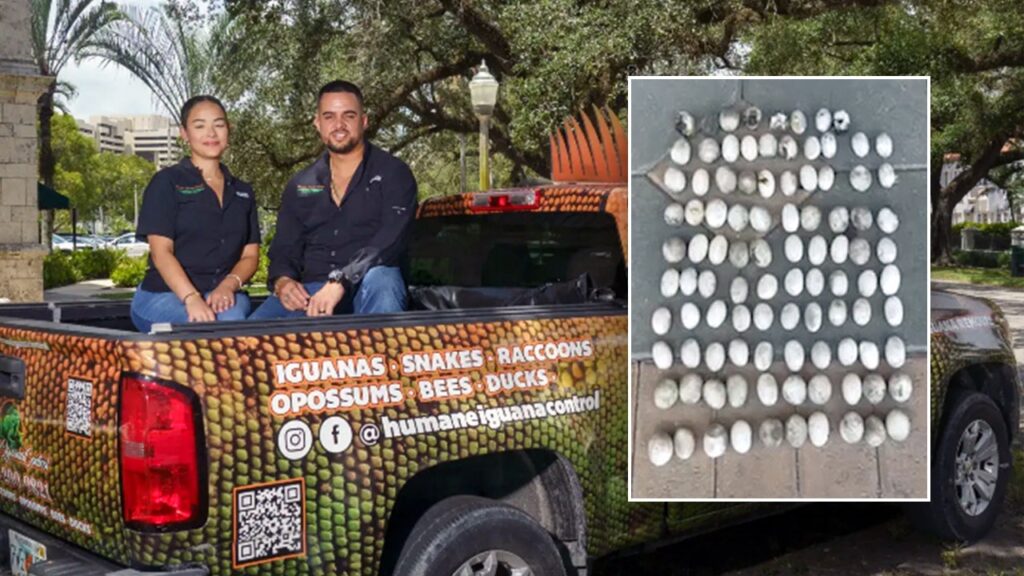In the realm of Florida’s wild inhabitants, it often appears that the most shocking discoveries occur far from the bustling streets of tourist hotspots like South Beach. One particular encounter in the pleasant suburbs of Palmetto Bay exemplifies this axiom, where a Miami homeowner found herself in a startling predicament involving a reptilian baby shower; she was unwittingly hosting 98 uninvited iguana eggs on her property.
Michael Ronquillo, owner of the operation known as Humane Iguana Control, was summoned to this unusual situation after the homeowner observed the unexpected guests. Upon his team’s assessment, they uncovered something that was astonishing even by Florida’s unique wildlife standards. “We removed 98 eggs,” reported Ronquillo to Fox News Digital. The astonishing quantity stemmed from three female iguanas that formed interconnected burrows in the yard, each laying their own distinct clutch of eggs. The endeavor ultimately may have set a local record, as Ronquillo stressed that such a significant quantity had never been extracted from a single site before.
For individuals outside of this vibrant state, particularly those less familiar with the persistent challenges of Florida’s invasive wildlife, this scenario might seem exaggerated. However, for the locals—especially those living in South Florida—it marks yet another chapter in the ongoing struggle against non-native species that proliferate unchecked. Ronquillo articulated the severity of the situation, emphasizing that iguanas are far more than a mere nuisance; they can pose serious health risks and can wreak havoc on landscaping. The burrowing activities of these creatures could lead to infrastructural damage, a fact illustrated by a notorious incident in West Palm Beach that incurred a staggering $1.8 million in damages as a compromised dam became a victim of iguana-related burrows.
The scope of the problem extends beyond just property damage; it reaches into the realm of public health. Ronquillo highlighted the sanitation issues associated with iguanas, indicating they often leave fecal matter around areas where children play, such as schools and playgrounds, creating a genuine health hazard. Interestingly, the reproduction capacity of these iguanas is remarkable, with a 93% hatch rate for their eggs, indicating that, had the homeowner not reached out for professional assistance, the local neighborhood could have faced substantial challenges within months.
What drew these iguanas to the homeowner’s yard—transforming it into a maternity ward for iguanas—was the specific attributes of the location. Ronquillo elaborated on this, explaining that iguanas typically test multiple spots for suitability before laying eggs. Ideal conditions include soft soil, shade, and proximity to water, making this particular yard the perfect nesting ground.
For homeowners finding themselves in similar predicaments, Ronquillo offers critical advice regarding the steps to take. The most common mistake is attempting to cover the burrows, which simply complicates the retrieval process. Instead, he recommends marking the burrows with visible indicators, like irrigation flags, and contacting a professional service. Ronquillo’s team employs various tools, including cameras and careful hand-digging techniques, to follow the paths of iguana tunnels, highlighting the intricacies of iguana movement and burrow construction.
Generally, iguana breeding season spans from February through May, although Ronquillo cautions that unexpected occurrences of baby iguanas may arise outside this timeframe, potentially extending through summer and into the fall months.
It’s essential to recognize that iguanas are not indigenous to Florida; they first appeared in the 1960s, introduced through the pet trade and as stowaways on freight ships. The state’s warm climate, abundant food sources, and absence of natural predators have led to an environment where iguanas flourish and multiply uncontrollably. They are now classified as a public nuisance, prompting state authorities to encourage humane removal efforts.
In summary, individuals encountering signs of iguana activity in their yards should refrain from taking matters into their own hands. Ronquillo warns against self-removal initiatives and certainly against using poisons. Instead, flagging these burrows and notifying licensed professionals is the recommended route. Notably, iguanas have their own mechanisms for defense, including sharp claws and the ability to whip their tails at alarming speeds, presenting risks to those inexperienced in handling these reptiles.
In the case of the Miami homeowner, a single informed call prevented the establishment of nearly a hundred invasive reptiles in her community. Ronquillo highlighted the significance of her proactive approach, noting that if more residents acted similarly, it could lead to substantial improvements in controlling iguana populations across Florida. His final remarks resonate with a plea for collective action, suggesting that every individual plays a vital role in protecting their neighborhoods and environment, akin to the actions taken by the homeowner who successfully mitigated a potential iguana infestation.
Jasmine Baehr, a writer for Fox News Digital and a military spouse based in New Orleans, provided the insights



